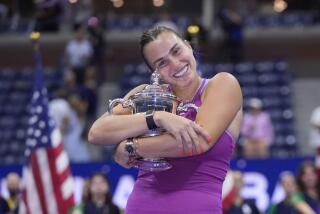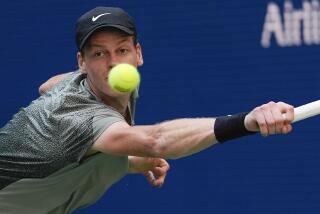It’s an Open Draw That Graf Could Love : Her Slam Chances Improve With Navratilova, Sabatini in Other Half
- Share via
NEW YORK — They made the women’s draw for this week’s U.S. Open at a hotel in midtown Manhattan last Thursday morning, and within minutes, one state away, Peter Graf’s day was made.
Virginia Slims tour liaison Ted Tinling--who umpired for Suzanne Lenglen and watched Margaret Court and Maureen Connolly complete their Grand Slams--sat in on this latest chapter in the history of women’s tennis, and he immediately left his table after the draw was announced. Tinling then telephoned the anxious Peter Graf, who was waiting by the phone in Mahwah, N.J., to find out the state of his daughter Steffi Graf’s Grand Slam chances.
Here was the news: Nineteen-year-old Steffi Graf was not in the same half of the draw as her young rival, Gabriela Sabatini, or the defending champion, Martina Navratilova. Sabatini, who has recorded the only two wins over Graf in 1988, and Navratilova would have to battle one another and/or a host of other dangerous players just to meet Graf in the final.
The only major seeded player that Graf would have to contend with in her half was 33-year-old Chris Evert, whom she hasn’t lost to since 1986.
“I said to Peter, ‘It’s a miracle draw,’ ” Tinling said. “He didn’t say anything. I said, ‘Peter, are you smiling?’ All he said was, ‘Yes.’
“He was so nervous the day before that he was shaking. I started shaking. We were like two jellyfish.”
They stopped shaking last Thursday. Today, as the 1988 U.S. Open begins, Graf is poised to take the final step of the most improbable Grand Slam, something people said couldn’t be done in the 1980s, especially on four different surfaces in the same calendar year.
In January, Graf beat Evert in straight sets to win the Australian Open on a new synthetic surface. In June, in Paris, Graf survived a second-set tiebreaker before defeating Sabatini on clay in the French Open semifinals and went on to beat Soviet teen-ager Natalia Zvereva, 6-0, 6-0, in the final. And a month later at Wimbledon, Graf spotted Navratilova the first set before rallying to win 12 of the next 13 games to win the title on grass.
Next up: The last leg, the U.S. Open, played on cement. In the next two weeks, Graf has the chance to join a select group of four players who have won the Grand Slam. The last time the feat was accomplished was 1970, by Margaret Court. She fought back to beat Rosie Casals--and her own nerves--at the fourth and final stop, the Open at Forest Hills, N.Y.
So what exactly in the name of Don Budge, Rod Laver, Maureen Connolly and Margaret Court is this teen-ager doing, as she tries to break into this elite circle of Grand Slam winners?
The way Graf looks at it, the club has been closed for 18 years and she’s not just campaigning to get in . . . she’ll break down the door if she has to.
Most of the experts, speculating on the eve of the Open, doubt that Graf will falter at the National Tennis Center in Flushing Meadow, N.Y.
“Steffi will win the Grand Slam unless she breaks her leg,” Billie Jean King said.
Mary Carillo, CBS and ESPN analyst, figures it would take even more than that to stop Graf.
“I think it would take either illness, injury and extreme nerves for her not to win it,” Carillo said. “Actually, I think you’d probably need a combination of those things. Those are the big three. But I think just one of them wouldn’t wipe her out. It would take more.”
Graf had an odd run-in with injury this summer. Back home in West Germany, she was playing with her dog Max and the German Shepherd bit her. Yes, on her right, playing hand. But Graf not only survived, she promptly won a tournament in Hamburg without losing a set, taped finger and all.
If Graf were to win the Grand Slam here, she won’t be the youngest player to complete the feat. Connolly, known fondly as Little Mo, won the Slam in 1953 at 18 just less than a year before her precocious career ended. Graf’s game reminds Tinling and others of Connolly because of her efficiency, style, sense of purpose and on-court concentration.
Carillo looks at the women’s field and sees just one player with any kind of momentum--Graf. Actually, with Graf’s year, you can call it, Big Mo. Sabatini started the year well, defeating Graf twice before the French Open. However, she faded badly at Wimbledon and looked sluggish this summer before rebounding to win the Canadian Open earlier this month.
The rest of the field, however, hasn’t kept pace.
If people thought Navratilova had a strange season leading up to last year’s U.S. Open, 1988 is more puzzling. Despite losing to Evert twice before Wimbledon, Navratilova won a handful of tournaments in the winter and spring and began to look again like the dominating player of the early ‘80s.
Once she got to Paris, however, everything stopped making sense.
Navratilova lost to the 17-year-old Zvereva at the French Open. This led Navratilova to later make a statement that from there on in, she was on a mission against all Russians. Although she beat Zvereva at Wimbledon, the mission blew up in Navratilova’s face earlier this month in Montreal when the Soviet teen-ager beat Navratilova again, losing just five games.
This time, Zvereva might be waiting for Navratilova again in the quarterfinals. First, Navratilova must get past a difficult first-round opponent, No. 28-ranked Catarina Lindqvist. If the draw goes according to form, Navratilova will play No. 13-seeded Mary Joe Fernandez in the fourth round, while No. 11 Zina Garrison will meet Zvereva. Fourth-seeded Pam Shriver, No. 5 Sabatini and No. 10 Claudia Kohde-Kilsch are in the upper quarter of Navratilova’s half.
On the other side, of course, are Graf and Evert. Evert’s biggest problem could be Houston’s Lori McNeil, seeded ninth, whom she could meet in the fourth round. McNeil came to prominence last year when she upset Evert here in the quarterfinals. However, McNeil has done little as far as major victories since last year’s Open. Evert has won one tournament and reached the semifinals of another since her recent marriage to Andy Mill.
No Mo, as in no momentum, is also the story in this year’s men’s field. The great U.S. hope, No. 4-ranked Andre Agassi, heads into Flushing Meadow with seven tournament victories--but with no wins over the top three players in the world--Ivan Lendl, Stefan Edberg and Mats Wilander. And in an official tournament, the 18-year-old hasn’t ever knocked off No. 5-ranked Boris Becker or No. 6 Jimmy Connors.
Lendl’s story is almost as perplexing as Navratilova’s. He began 1988 hoping for, and as it turned out, dreaming about a Grand Slam. That dream ended quickly for him with a semifinal loss to Pat Cash at the Australian Open in Janaury. Since then, Lendl hasn’t appeared in a Grand Slam final, but he is the three-time defending champion at the Open.
“I don’t have a solid pick yet,” Carillo said. “But Lendl deserves the nod, but just the barest of nods. You wouldn’t be able to see my head even bob up and down.”
Hardly a ringing endorsement. But who else is there? The third-seeded Edberg has turned in mixed results since his Wimbledon title, the biggest victory of his career. But, Edberg would have to get past Wilander, a longtime nemesis. Wilander beat him in last year’s Open, this year’s Australian Open and this month’s Assn. of Tennis Professionals Championship in Cincinnati.
Wilander, though, has his own problem in the form of the elusive, eighth-seeded Miloslav Mecir. Wilander could meet the Czech player before getting to Edberg, in the quarterfinals. At Wimbledon, Wilander had his hopes of a Grand Slam dashed by a one-sided loss to Mecir in the quarterfinals.
Also in this half are No. 5 Becker, No. 10 Henri Leconte, No. 11 Brad Gilbert and No. 16 John McEnroe. The up-and-down McEnroe would have to play Wilander in the round of 16, if he gets past Australian Mark Woodforde, who recently beat McEnroe in Canada.
“Mac is in trouble,” Carillo said. “Woodforde could be a lot of trouble for him. . . . McEnroe is an extreme longshot to win.”
“I picked Agassi to do well last year even though he was No. 90 in the world because he had a dream draw,” Carillo said. “And he lost in the first round. I’m going to be very bold and pick him again. He has a lot of momentum, but has never beaten Lendl, Becker or Wilander.
“But I would give him a chance to win the Open because on a good day, I think he can beat anyone in the world.”
The sporting world doesn’t have that problem with the heavy favorite, Graf. She has dropped just one set in Grand Slam play in 1988. And she has lost only twice the whole year. So, barring injuries or plague or pestilence, Graf will likely inherit the Budge-Laver-Connolly-Court legacy in two weeks’ time.
Carillo has one last idea, one last possible road block to Graf’s ascendancy.
“A pack of wild dogs at the Open,” she said, laughing, “Not just one dog, a whole pack. That’s what it would take.”
More to Read
Go beyond the scoreboard
Get the latest on L.A.'s teams in the daily Sports Report newsletter.
You may occasionally receive promotional content from the Los Angeles Times.











